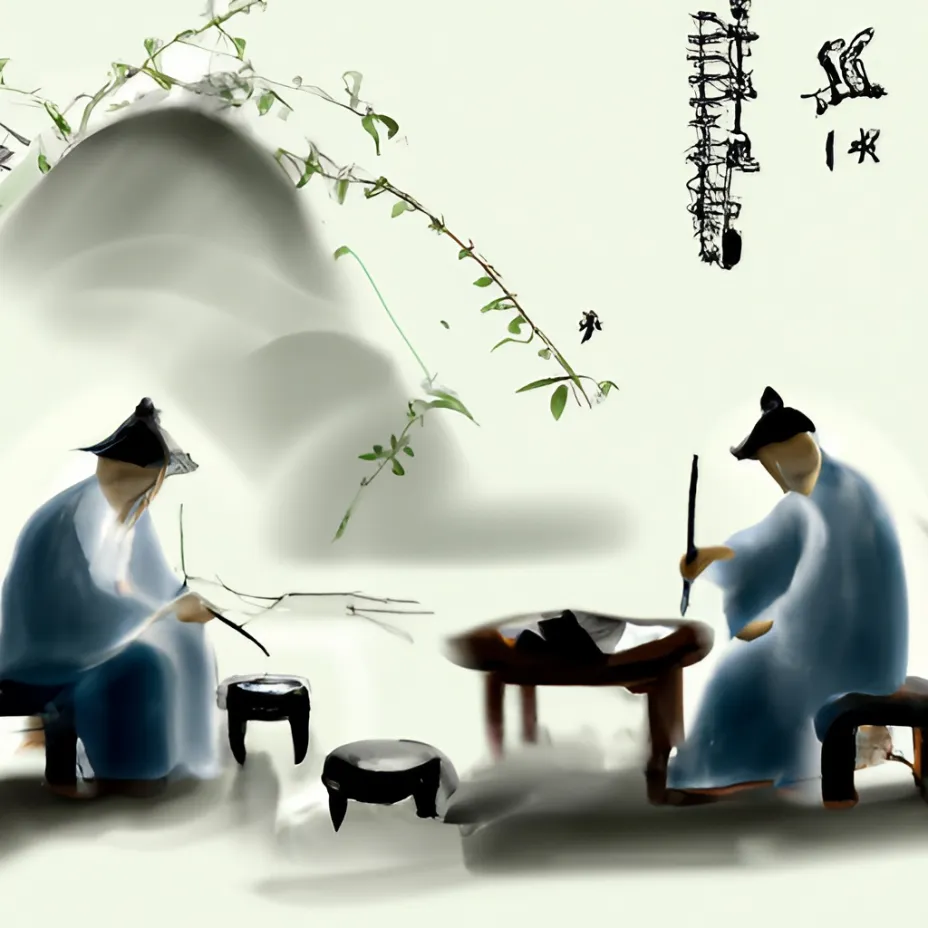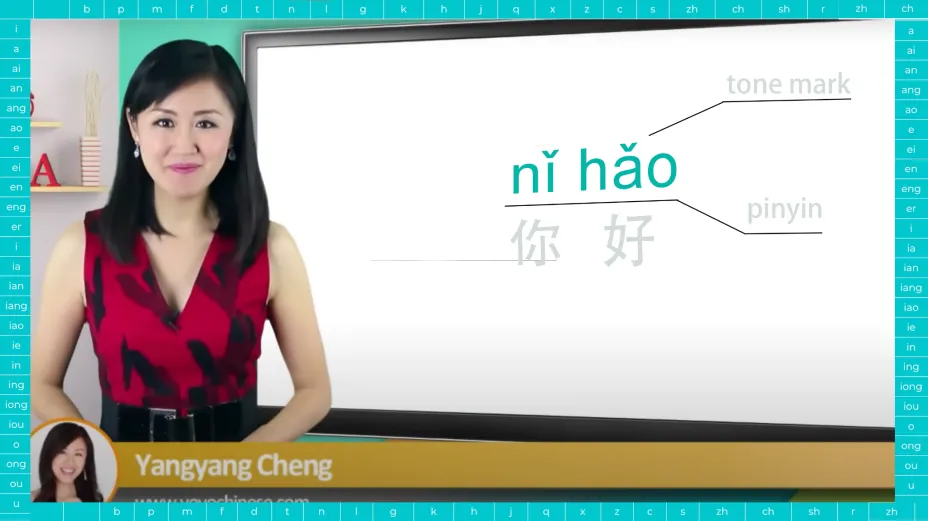
What is Pinyin?
Pinyin is a system used to represent the sounds of the Mandarin Chinese language using letters of the Latin alphabet. It is crucial for learners of the Chinese language students because it enables them to learn how to pronounce Chinese words before they tackle the complex and difficult Chinese writing system.
To represent the sounds of Chinese, Pinyin uses a combination of 26 Roman letters and diacritics (accent/tone marks). It is frequently employed as a tool to assist students in mastering proper Chinese pronunciation and speech, as well as for entering Chinese characters into computers and other electronic devices.

Best Online Lessons to Learn Pinyin
Any English speaker that wishes to learn to speak Chinese must first start by establishing a solid foundation of understanding of pinyin. After all, even native Chinese speakers start with pinyin as children! We love this beautiful language and want to help as many people as possible learn Chinese in a fun and successful way, so we've built the Yoyo Chinese online learning platform with 6 comprehensive courses and a huge number of study tools and resources. We even made the first lessons completely free, and they thoroughly cover everything you need to build that foundational knowledge of pinyin. Just click here to try them right now and launch your Chinese language learning journey today!
Want to really start
learning Chinese?
Try Yoyo Chinese for free!

Pinyin - The Closest Thing to a Chinese Alphabet
Pinyin is similar to a Chinese alphabet in that it is a system of writing used to represent the sounds of Mandarin Chinese. However, it is not the Chinese alphabet because it is not used as the Chinese writing system, which instead uses logographic characters (explained more later in this article).
Pinyin uses the Roman alphabet to represent the sounds of the Chinese language, and it is often used as a tool to help those that want to learn Chinese to pronounce words and phrases correctly. The Chinese writing system, on the other hand, uses thousands of complex characters to represent ideas & concepts. These characters are not based on the Roman alphabet, and they are much more complex than the letters used in Pinyin.
Overall, Pinyin is a useful tool for learners of Chinese, but it is not a true alphabet or a substitute for learning the Chinese writing system.
Brief History of Pinyin
Pinyin was created by a team of Chinese linguists under the direction of Zhou Youguang in the 1950s. The system was devised as a more precise and standardized approach to use the Roman alphabet to represent the sounds of Mandarin Chinese.
Prior to the creation of pinyin, there were numerous Romanization schemes for Chinese in use, each with its own set of rules and norms. Because of this, it was challenging for non-native Chinese speakers and those studying the language to interact with one another and use Romanization as a learning tool.
The government of The People's Republic of China formally adopted pinyin as the official Romanization system for Chinese in 1958. Since then, it has been widely employed for a range of tasks, such as teaching Mandarin Chinese, entering Chinese characters into computers, and representing Chinese names in works written in other languages.

How Pinyin Works
Here are the basics of pinyin:
- Pinyin uses Roman letters to represent the sounds of Chinese. Even though these letters are the same as those found in the English alphabet, some of them are used to represent different sounds than their English counterparts in order to match those found in Chinese. Our Interactive Pinyin Chart and video lesson series are great resources for getting familiar with pinyin.
- Pinyin also uses diacritics - also known as accent marks - to represent tones. See this video lesson for an intro to tones.
Here are some examples of how pinyin is used to represent the sounds of Chinese:
- The Chinese character 妈 means "mother", and is represented in pinyin as "mā", with the diacritic "ā" indicating the first tone.
- The character 十 means "ten" and is written in pinyin as "shí", with the diacritic "í" indicating the second tone.
- The character 好 means "good" and is written in pinyin as "hǎo" in pinyin, with the diacritic "ǎ" indicating the third tone.
- The word 爸爸 means "dad" and is written in pinyin as "bà ba", with the diacritic "à" indicating the fourth tone.

Benefits of Using Pinyin
There are several benefits to using pinyin as a tool for learning Chinese:
- Ease of use: Pinyin is relatively easy to use, especially for learners who are already familiar with the Roman alphabet. It is much simpler to learn than written Chinese, which requires a significant amount of time and effort to master.
- Focus on pronunciation: By using pinyin, learners of Chinese can focus on learning the sounds of the language and the rules of pronunciation, rather than having to spend a lot of time and effort learning the thousands of characters used in Chinese. This can make it easier for learners to quickly learn how to speak and understand spoken Chinese, and can also eventually help them to read and write Chinese characters more quickly and accurately.
- Inputting Chinese characters into electronic devices: Pinyin is often used as a way to input Chinese characters into computers and other electronic devices. This allows learners to type in Chinese without having to remember the complex strokes and radicals used in written Chinese. Here's our article showing you How to Type in Chinese On Any Device.
- Representing Chinese names: Pinyin is also often used to represent Chinese names, making it easier for people who are not familiar with Chinese characters to pronounce and spell them correctly.
Limitations of Pinyin
While pinyin is a useful and effective tool for learning Chinese, it does have some limitations. These include:
- Pinyin can be confusing for new learners: Pinyin has its own set of rules and conventions that may be confusing for learners who are not yet familiar with them. For example, a new learner might see the pinyin syllable "hē" and pronounce it like the common English pronoun "he"; but this would be incorrect pronunciation. Learners need to remember that pinyin has its own set of pronunciation rules. You can learn more with these free video lessons.
- Pinyin cannot replace the Chinese writing system: Pinyin is a system of Romanization, which means that it represents the sounds of Chinese using the Roman alphabet. It is not equivalent to written Chinese, which is made up of thousands of characters that represent both sounds and meanings. This means that learners of Chinese will still need to learn the Chinese characters in order to read and write in Chinese. Good thing we have awesome courses for that!
Frequently Asked Questions
-
What is pinyin?
Pinyin is a writing system used to represent the sounds of Mandarin Chinese using a combination of the letters of the Roman alphabet and special diacritics (accent/tone marks). It is widely used in China and around the world by those new to the language including non-native speakers and Chinese children.
Want to learn more? Check out our Interactive Pinyin Chart and comprehensive courses with a real-life expert teacher!
-
Is pinyin the only system of Romanization used for Chinese?
Although it is not the only Romanization system of Chinese, Pinyin is the most popular. Wade-Giles, Yale, and Gwoyeu Romatzyh are a few other Romanization methods that have been applied to Chinese over time.
One of the first methods of Romanizing Chinese was Wade-Giles, which was widely used in the English-speaking world until the middle of the 20th century. Yale is a Romanization system that is similar to pinyin but represents Chinese sounds using different letter combinations and rules. Some academics and linguists still employ yet another Romanization method known as Gwoyeu Romatzyh, which was created in China during the 1920s and 1930s.
While these other systems of Romanization are still used by some people around the world, pinyin is now the most widely used system of Romanization for Chinese by far, and it is the official system of Romanization in China. It is also the system that is most commonly used by non-native learners of Chinese around the world.
-
Why is pinyin important for learners of Chinese?
Pinyin is important for learners of Chinese for several reasons:
- Pinyin is relatively easy to use: Pinyin is easier to learn than Chinese characters, which require a significant amount of time and effort to master. This makes it a useful tool for new learners of Chinese that want to learn how to speak and understand quickly.
- Pinyin allows learners to focus on pronunciation: By using pinyin, learners of Chinese can focus on learning the sounds of the language and the rules of pronunciation, rather than having to spend a lot of time and effort learning the thousands of characters used in written Chinese. This can make it easier for learners to speak and understand spoken Chinese, and can also help them to read and write in Chinese more quickly and accurately.
- Pinyin is useful for inputting Chinese characters into electronic devices: Pinyin is often used as a way to input characters into computers and other electronic devices. This allows learners to type in Chinese without having to remember the complex strokes and radicals used in written Chinese. Here's our article showing you How to Type in Chinese On Any Device.
- Pinyin is used to represent Chinese names: Pinyin is also often used to represent Chinese names, making it easier for people who are not familiar with characters to pronounce & remember them.
Overall, pinyin is an essential tool for learners of Chinese, as it allows them to focus on pronunciation and speaking the language, rather than having to spend a lot of time and effort learning the written characters.
-
How do I use pinyin to input Chinese characters into a computer?
Most computers and electronic devices feature built-in input mechanisms that let users enter pinyin and have the relevant characters show on the screen. They typically utilize predictive text and other features that make it much simpler and quicker to type Chinese characters than the handwritten character input option. Here's our article showing you How to Type in Chinese On Any Device. Here's our article showing you How to Type in Chinese On Any Device.
-
How do I use pinyin to pronounce Chinese words and phrases correctly?
To use pinyin to pronounce Chinese correctly, follow these steps:
Learn the basic principles of pinyin: Pinyin uses a combination of letters and diacritics to represent the sounds of Chinese. Check out our Interactive Pinyin Chart and comprehensive courses to learn everything you need to know about pinyin! By learning the rules of pinyin, you will be better able to pronounce Chinese correctly.
- Practice pronunciation: Practice pronouncing Chinese words and phrases out loud, using our Interactive Pinyin Chart to help you. Pay attention to the tones, as they are an important part of the pronunciation of Chinese.
- Use audio resources: Listen to native speakers of Chinese pronouncing words and phrases in pinyin, and try to imitate their pronunciation. This will help you to get a feel for the rhythms and sounds of the language. Our online courses are filled with audio recordings of native Chinese speakers for that very reason!
- Use resources like flashcards: Use resources like flashcards to practice recognizing and pronouncing Chinese in pinyin. You can create your own flashcards or use the thousands of flashcards we've created for you at YoyoChinese.com!
By following these steps and practicing regularly, you can use pinyin to pronounce Chinese correctly. It is important to be patient and to keep practicing, as it can take time to learn the sounds and rhythms of Chinese.
-
What are tones and how are they represented in pinyin?
Mandarin Chinese has five tones, which are an important part of the pronunciation of the language. The tones are represented in pinyin by different diacritics (accent marks). The four tones in Mandarin Chinese are:
- First tone: The first tone is a high, level pitch. It is represented in pinyin by the diacritic "ā"
- Second tone: The second tone is a rising pitch. It is represented in pinyin by the diacritic "á"
-
Third tone: The third tone is a
falling-rising pitch. It is represented in pinyin by the
diacritic "ǎ"
(This one is a bit tricky, so definitely check out our video lesson on it!) - Fourth tone: The fourth tone is a falling pitch. It is represented in pinyin by the diacritic "à"
- Neutral tone: The neutral tone is a mid-range, short pitch. It is represented in pinyin without a diacritic: "a"
Here are some examples of how the tones are represented in pinyin:
- The word 妈 means "mother", and is written in pinyin with a first tone like this: mā
- The word 麻 means "hemp", and is written in pinyin with a second tone like this: má
- The word 马 means "horse", and is written in pinyin with a third tone like this: mǎ
- The word 骂 means "to scold", and is written in pinyin with a fourth tone like this: mà
- The word 吗 turns a statement into a yes/no question, and is written in pinyin with a netural tone like this: ma
-
How is pinyin different from Chinese characters?
Pinyin is a system of Romanization that represents the sounds of Chinese using the Roman alphabet, while Chinese characters are the true writing system used by Chinese speakers to represent the ideas & concepts of the Chinese language.
Pinyin is used to help learners of Chinese pronounce words and phrases correctly, and it is often used as a tool to input characters into computers and other electronic devices.
There are several key differences between pinyin and Chinese characters:
- Alphabet vs. characters: Pinyin uses the Roman alphabet to represent the sounds of Chinese, while characters are the main way Chinese speakers write in the Chinese language.
- Pronunciation vs. meaning: Pinyin is primarily used to represent pronunciation, while characters represent mainly ideas or concepts.
- Ease of use: Pinyin is generally easier to learn and use than characters, especially for new learners of the Chinese language.
Overall, pinyin and characters are two different systems used for different purposes. Pinyin is a useful tool for learners of Chinese, while characters are used to represent the written form of the language.
-
Is pinyin the Chinese alphabet?
Pinyin is not the Chinese alphabet, since the Chinese writing system doesn't use an alphabet. Instead Chinese uses logographic characters as taught in our course here. Pinyin is a system of Romanization that represents the sounds of Mandarin Chinese using the Roman alphabet for the sake of learning the language.
Chinese characters are the symbols (logograms, to be precise) used to write the Chinese language, and they have been used for more than 4,000 years. They are complex symbols that represent the concepts of Chinese words, and each character is made up of 1-56 individual strokes.
Pinyin, on the other hand, is a system of Romanization that was developed in the 1950s to represent the sounds of Chinese using the Roman alphabet. It is often used as a tool to help learners of Chinese pronounce words and phrases correctly, and it is also used to input characters into computers and other electronic devices.
While pinyin is not the Chinese alphabet, it is a useful tool for learning the pronunciation of Chinese and for inputting characters into computers and other electronic devices.
-
Can I use pinyin to learn to read and write in Chinese?
New learners of Chinese could use pinyin for written communications with native speakers and fellow Chinese learners. But to learn to read and write Chinese as it is used by native speakers around the world, you will need to learn characters. This can be a challenging and time-consuming process, but it's also a very interesting and rewarding learning process! We created our Chinese Characters Course to help you learn in the most enjoyable and effective way possible!